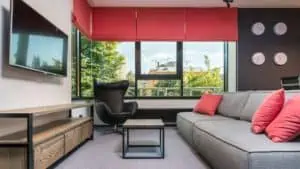Look around your home. What do you see?
Walls. Flooring. Maybe a built-in or two. For some reason, despite their prevalence, windows get forgotten in homeowners’ design plans.
Many people become accustomed to ignoring window treatments in their young adult lives. Every apartment or townhouse you rented probably had those standard mini blinds and maybe a set of vertical blinds covering the sliding glass door. After all, why adjust a place you are just renting anyway?
Unfortunately, the feeling of indifference towards window coverings tends to carry over into adulthood and homeownership. Many homes come with standard treatments or bare windows that are covered with inexpensive, low-quality options out of desperation.
There are other reasons window treatments fall by the wayside when a to-do list is being developed.
They rarely get considered as a necessary item. Can I afford new window treatments when I really need a washer and dryer? I definitely want a new television before football season, let’s just keep the mini blinds a while longer.
Homeowners tend to see new window coverings as expensive and downright complicated. The measuring, calculating, and installation are all daunting steps that must be taken with new window treatments. Anything will do in the eyes of most people less concerned with interior design and more focused on other home improvements. Until you realize your carpets are fading, neighbors can see inside, or criminals might be lurking about, that is.
There is need for window treatments
Once you decide the need for new window treatments is more pressing than you thought, the stress of pulling the project together can be overwhelming. Have confidence I knowing there are two ways you can go: hire a professional or take it on yourself.
Hiring someone can help in a few ways. You could seek out a full-service shop that will measure, order, and install everything for you. Or you could hire someone to come to do the measurements and hang the treatments as a DIY project. Measurement is often considered the most challenging part of new window treatments and is the most critical step. Most “big box” retailers can send someone out to help if this is the one part of the process holding you back.
Obviously, money does not grow on trees and budgeting is always a part of any home project. The good news is there is an option for virtually every budget to upgrade your home from poor or nonexistent window treatments to something attractive, efficient, and functional.
After budgeting, it will be time to make some decisions. Rather than simply deciding between blinds, curtains, shades, or shutters, consider why you want or need new window treatments. Is your privacy of utmost importance? Do you need the best light control? Are you wanting a new, modern look? Are there HOA restrictions to consider? Answering some of these questions may point you in a direction rather than trying to make your wants fit your needs.
As mentioned earlier, there are four main options when considering window treatments. Blinds, curtains, shades, and shutters round out the typical choices for form and function. Here is a quick breakdown of each covering.
Blinds
These window treatments are popular in any setting, from apartment, to house, to businesses. Why? Simply because they are the least expensive. You can get blinds at the rock bottom prices that are attractive to those on a tight budget.
From an interior design standpoint, blinds are a type of hard window treatment due to their common materials: plastic, metal, and wood. Function is the name of the game with blinds as they are openable, closable, and offer light filtering and privacy.
This is not to say that blinds are always cheap and unfashionable. There have been numerous upgrades to the old standards including numerous color options, new materials (faux wood or fabric), and better function like cordless operation.
Curtains
Curtains scare people who lack the imagination and fashion sense of interior design experts. There are hundreds of fabrics and millions of patterns waiting to confuse, frustrate and send homeowners into a spiral of indecision. Not to pile on but choices about the headings (where the curtain meets the rod) abound, too.
Take a deep breath. Curtains can be your friend! Think of it this way, at the very least measurement is easier because the pressure of an exact fit is less intense.
Interior designers consider curtains a soft window treatment for obvious reasons. Aside from aesthetics, it is important to remember that fabric is vulnerable to the sun’s harsh rays. If a window gets a lot of bright light, consider a lighter-color fabric to avoid fading.
Measuring for curtains is far simpler, as we mentioned, but keep in mind they should generally hang to about one inch above the floor. It is possible to hem curtains if they come out a little long for your liking.
Many window treatment specialists offer custom cuts and prefabricated lengths to fit different budgets.
Shades
Shades are an upgrade to blinds and often represent a more expensive option. Many designers consider them better looking but you must consider that they do not open and close like blinds. When you shop for shades, keep in mind how opaque they are. This determines how much light is let in when the treatments are pulled down.
Shades come in three types. You can find roller shades (aptly named, as they roll down from a tube), Roman shades (folded), or honeycomb shades (also called cellular). Cellular shades are mostly used in rooms where energy efficiency is at a premium because their layers provide insulation.
While this type of window covering is clearly a pricier option than standard blinds, there are some budget-friendly roller shade options available.
Shutters
Many people assume that shutters are only for the exterior of a home (like storm shutters) but this window treatment has made its way into interior design circles lately. Their sturdy, heavy materials play a role in a higher price point, but many feel the look is worth the cost.
If you are going to install interior shutters, it is most beneficial to see the help of a professional. Most installations are custom, and a mistake can throw off the entire project.
Some outlets do offer prefabricated options for typical window sizes. Unfortunately, “typical” window size is a bit of a wives’ tale. Custom measurements and fabrications are highly recommended when it comes to investing in shutters.
Do Not Be Intimidated by New Window Treatments
If you feel like you cannot lead the way with new treatments, whether it be from a design or measurement standpoint, do not let that hold you back. Contact a window treatment specialist. They can walk you through the steps to take and help you along the way.
Calling a professional can save you hours and even money in the long run. Even if you are a DIY homeowner, a little help can go a long way toward selecting and installing the perfect window treatments for your wants and needs.





